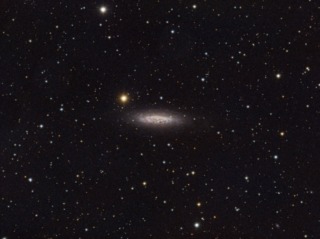
- Constellation: Draco
- Right Ascension: 17h 49.4m 00s
- Declination: +70° 09′ 00″
- Distance: 18 million ly
NGC 6503 Nicknamed the Lost in Space Galaxy as it sits on the edge of an area of space devoid of galaxies that is called the Local Void. A dwarf galaxy at one third of the size of the Milky Way it located in Draco at a distance of 17 million light years away. Also tracked down two quasars that are visible in the image.
Imaged with the ES127 refractor and Atik314l+ mono camera over multiple nights.
- Details
- Category: Galaxies
- Telescope: Explore Scientific 127 Refractor
- Camera: Atik 314l+
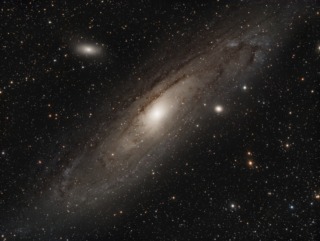
- Constellation: Andromeda
- Right Ascension: 00h 42m 44.3s
- Declination: +41° 16′ 9″
- Distance: 2.5 million ly
Messier 31, or more commonly known as the Andromeda Galaxy, is one of the largest members of our local group of galaxies. Charles Messier added it to his catalog in 1764.
Until 1917 it was thought it was just a nebula located in our galaxy until Heber Curtis observed several nova in M31 and recorded they were about 10 magnitudes dimmer than the local ones in our galaxy. He proposed that M31 was a separate galaxy apart from ours. His theory wasn't proven until 1923 when Hubble measuring Cephid variables visible in M31 and measured its distance at 750,000 light years. In 1943 Walter Baade doubled the distance by measuring the different types of stars in the central region of the galaxy, and discovering two types of Cephid variable stars in the galaxy.
The galaxy is thought to have been shaped by the merger small galaxies 10 billion years in the past, and it appears the Andromeda galaxy and the Milky Way galaxy may merge in around 4 billion years.
- Details
- Category: Galaxies
Read more: Messier 31 - The Andromeda Galaxy
- Telescope: EDT 80mm Reftactor
- Camera: ZWO 1600 MM
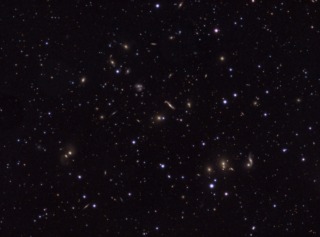
- Constellation: Hercules
- Right Ascension: 16h 05m 15.0s
- Declination: +17° 44′ 55″
- Distance: 500 million
The Hercules Galaxy Cluster or its more more formal designation of Abell 2151, contains some 200 to 300 galaxies located approximately 500 million light years away. Imaged with the Es127 refractor and the Atik 314L+ mono ccd.
This image shows the location of many of the galaxies in this image, there are still others that aren't cataloged.
- Details
- Category: Galaxies
Read more: Hercules Galaxy Cluster (2018)
- Telescope: Explore Scientific 127 Refractor
- Camera: Atik 314l+
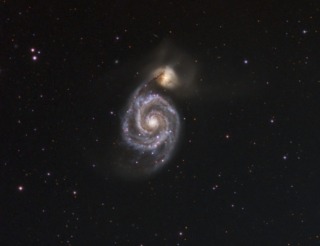
- Constellation: Canes Venatici
- Right Ascension: 13h 29m 52.7s
- Declination: +47° 11′ 43″
- Distance: 23 million ly
Messier 51 and it's interacting companion galaxy NGC 5195. First categorized by Charles Messier in October 1773, and in 1845, William Parsons first saw the spiral structure. It was the first "nebula" to show a spiral structure. In Edwin Hubble was able to show these "nebula" were far outside of our galaxy by measuring the brightness of Cepheid variable stars located in the object.
Interaction between M51 and NGC 5195 has led to increased star formation in the system and may have accounted for its pronounced spiral structure.
Imaged with the Es127 refractor and the Atik 314l+ mono camera.
- Details
- Category: Galaxies
- Telescope: Explore Scientific 127 Refractor
- Camera: Atik 314l+
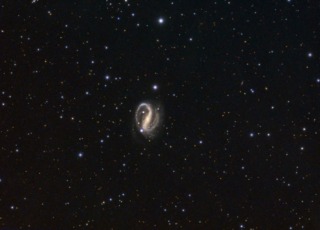
- Constellation: Pegasus
- Right Ascension: 23h 04m 56.6s
- Declination: +12° 19′ 22″
- Distance: 105 million ly
Located in the constellation of Pegasus, NGC7479 is a barred spiral galaxy at a estimated distance of 105 million light years. The galaxy is has been undergoing rapid star formation in its nucleus and outer arms possibly due to a merger with a smaller galaxy. Imaged with the Es127 refractor and Atik 314l+ mono ccd camera over various nights for the last month.
- Details
- Category: Galaxies
- Telescope: Explore Scientific 127 Refractor
- Camera: Atik 314l+

- Constellation: Virgo
- Right Ascension: 12h 34m 20.310s
- Declination: +08° 11′ 51.94″
- Distance: 54 million ly
Sometimes called the Lost Galaxy, not because it has been lost, but but because it was difficult to see with 1950's technology. NGC 4535 is a barred spiral galaxy contained in the Virgo cluster of galaxies. It is estimated to be 54 million light years distant, and the galaxy spans 117,000 light years across.
- Details
- Category: Galaxies
- Telescope: Explore Scientific 127 Refractor
- Camera: Atik 314l+